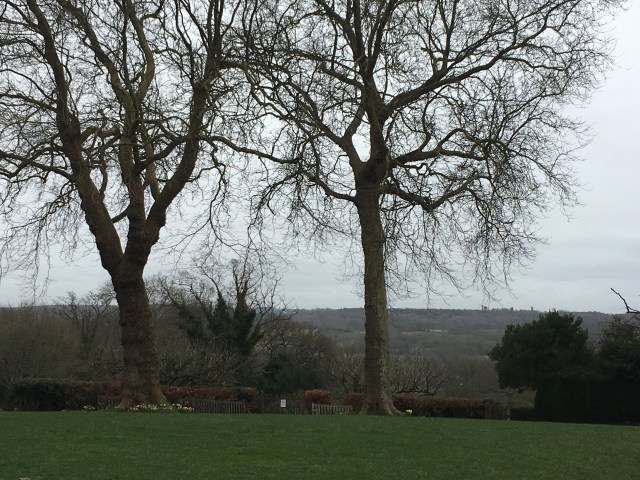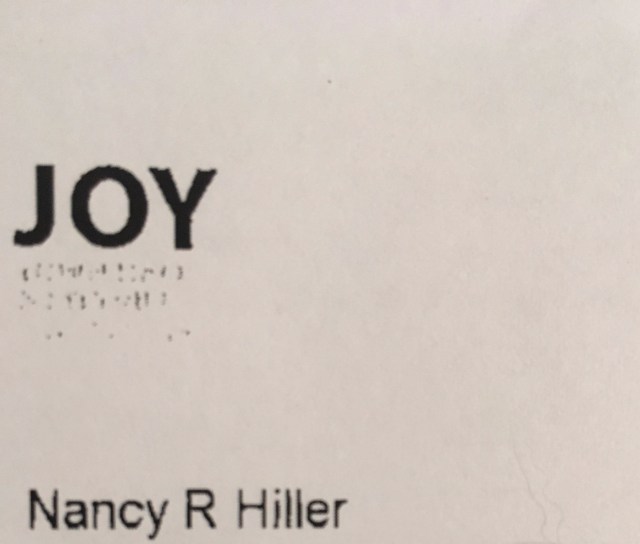or…watch Nancy Hiller morph into Basil Fawlty

I take copyright and permissions protocols seriously. It’s a simple matter of the Golden Rule: I write and design stuff, and if someone’s going to use my words or designs, I’d like my part in the process to be acknowledged. I have no right to expect this consideration from others if I’m not willing to give it myself.
So I paid attention to what the museum staff told me when I visited the marvelous Wilson Museum in Cheltenham last winter to measure one of their Voysey chairs. I signed a bunch of forms agreeing to their terms, which require written permission to publish photographs of their holdings, even in a blog post.
In early July, as I neared completion of my manuscript for a book on English Arts and Crafts furniture*, I thought readers might be interested in seeing some of the details I found while peering under aprons, stretchers, and such in the course of my research – you know, stuff like through tenons, decorative gouging, and artfully chamfered rails…but also the occasional cupped table top, gap at a tenon shoulder, or split stile. It’s tempting to attribute perfection to our craftsperson-heroes, but one of the things I love most about furniture is its decidedly human imperfection; I’m intrigued by the question of what we’re willing (or not) to live with.
So I dutifully wrote to my museum contact, requesting the necessary permission.
“Dear Nancy,” he wrote back. “Thank you for your email. Permission would need to come from our decorative arts curator, however she is currently away from the office until [a date ten days later], so I will be unable to get a response to you before then. I shall pass your message on to [her] and bring it to her attention when she returns. I hope that this helps.
Best wishes,
B.”
Ten days later I received another missive. “Hi Nancy,” he wrote. “Thank you for your patience whilst the decorative arts curator was away. For using images of our collections in blog posts there is a small charge of £16.70 per article/blog post. We also request that you would send us a link to the blog post so we can have a record of how the collections are being used.
Please let me know if you are still interested in proceeding. If you are interested in proceeding please let me know and I will send the relevant forms and arrange payment.
I hope that this helps.
Best wishes,
B.”
I wrote back immediately. Of course I was happy to pay to use the images. Museums — especially those, such as The Wilson, which don’t charge visitors an entrance fee — depend on this kind of revenue. A few days later I received the form by email, which I completed and signed. A week went by. Then:
“Dear Nancy,
Apologies for not getting back to you… We are currently experiencing issues with our payment facilities so we cannot accept payment just yet. How soon do you need to use the images?
Many thanks for your patience whilst we are working on resolving the payment issues.
B.”
I told him that I wouldn’t need to use the images for at least the next three weeks. “Hopefully we shall have this rectified before 31st August,” he wrote back. I hated to think of a museum not being able to take credit card payments over the phone in this day when plastic is the coin of the realm.
A month later B wrote back. The problems were ongoing. “We can accept cheques if all else [should] fail, although I understand the postage from America would inflate the real price at your end.” It wasn’t the postage that troubled me, but the fee a bank would charge for any form of payment other than a credit card. I’d already called my bank. They no longer issue checks in foreign currency but said they could wire the money for a $50 fee. Screw that.
The next week the ever-charming (truly) B wrote again.
“Dear Nancy,
The cost…was £16.70 plus VAT so that would be £20.04 overall [about $27]. I have been talking to the finance department and they believe[] they have resolved the issue, they are checking one final thing and have assured me that we should be able to take card payment over the phone by Monday. I shall email you again on Monday with the hopefully happy news. Again, please accept my apologies for the ongoing delays.
Best wishes,
B.”
Just to be on the safe side I gave it a few more days. On Thursday morning I was ready to call. The landline seemed a better bet than a cell phone. I dialed the number but got a sound that clearly signified a problem. I repeated the process several times, omitting various prefix digits in case they were unnecessary. Still no joy. I called the phone company again.
“All calls to international numbers are blocked at present,” the clerk informed me. Can this really be happening? I wondered. It seems that fraudsters overseas have been calling US households and threatening the vulnerable among us with harm to their relatives if they don’t return the call and fork over thousands of dollars. “So you’re blocking ALL international calls because a few people have fallen for this kind of scam?” I asked. Apparently so. “Is this just you, or all phone companies? Because this seems like serious overkill. I am just trying to make a business call to England.” She couldn’t say whether our phone company was alone in taking this paternalistic tack.
“You can bypass the call block by using this code,” said the clerk, reading out a symbol and three numbers. I thanked her and tried the call again, this time with the code. The call dropped as soon as I dialed. I tried again. Same thing.
I called the phone company back. Another clerk this time; he said I’d have to make some kind of different arrangement, aside from the code, to call overseas. “I am trying really hard not to pepper your eardrum with expletives,” I answered, taking a deep breath. “I just want to make a simple business call to England. England! Not Nigeria. Not Myanmar. I just need to make a credit card payment to a museum. In the past, all I had to do was dial the number. I’m not willing to go through yet more steps. I’ll use my cell phone.”
So I dialed the museum’s number on my cell. The call was answered by a woman whose first language was clearly not English. “I need your name,” she said after the usual pleasantries. I stated my first name and she proceeded to type, reading the letters back – incorrectly. I corrected her, knowing that the charge would be declined by the credit company, were the merest detail garbled. Then we got to the address. Between the spotty quality of the audio (even with Wi Fi calling) and our linguistic disjunct, it was taking forever. We got through the four digits of the street address, but the word “South” caused a problem. “Was that ‘ah‘?” she checked. “No, SOUTH,” I said. At this point I was not prepared to attempt the Himalayan peak of the next word, “Garrison.”
“Can I just email you this information, then call back?” I asked.
“Sure. That would be good. Thank you.”
So I sent the email, and she replied that she was ready to take my credit card information in a second call. I called her back at once. The phone was answered by a machine informing me that no one was available but I could leave a message if I would like.
I checked the time. 4 p.m. GMT. Perhaps they had just closed? I wrote back to her straight away, dreading the prospect of having to repeat the process with someone new the next day. But lo! Five minutes later I got a reply. The long-suffering staff person had been busy with a visitor, and so, unable to take my call. I called back.
Miraculously, we get the job done. I have the receipt to prove it:

All of which is to request that you refrain from blithely copying and reusing the images you will find in my post about the museum visit, which will arrive in your inbox a few days from now.
Please note: Although this post concerns one particular institution, I have enjoyed remarkably similar experiences with several others. I am a huge fan of The Wilson and highly recommend a visit.
*scheduled for publication by Popular Woodworking in May 2018. In the meantime, you can read Making Things Work